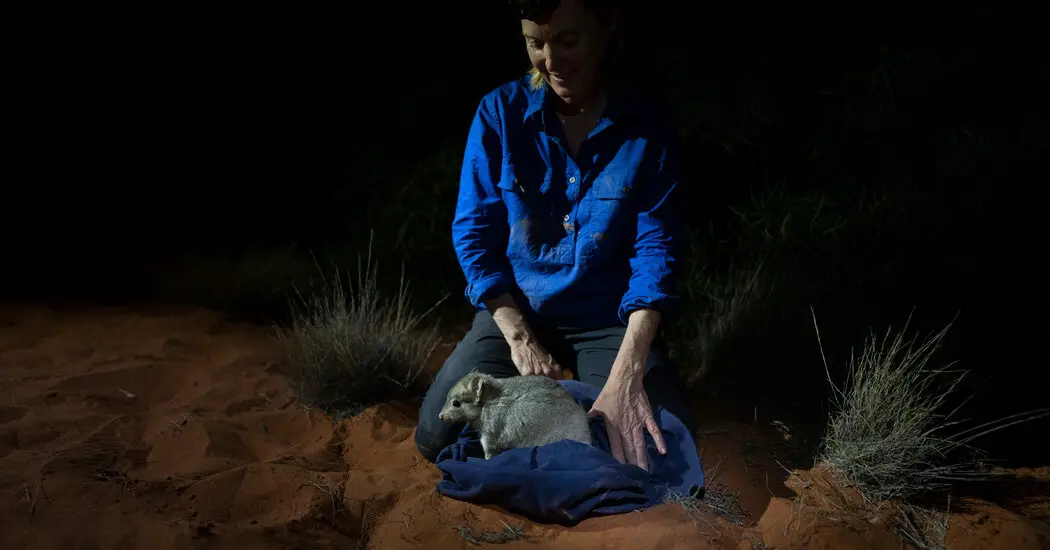News
‘Catastrophic Cats in Australia’

In Australia, ‘Cats are Just Catastrophic’
Katherine Moseby wanted to be clear: She does not hate cats. “They’re a wily beast,” she said, as her truck rumbled down a desert road. “But I respect them. They’re pretty incredible animals. Amazing hunters. Very smart.”
That was precisely the problem, said Dr. Moseby, the principal scientist and co-founder of Arid Recovery, a conservation nonprofit and wildlife reserve in South Australia. Cats are not native to Australia, but they have invaded nearly every corner of the country. She gestured out the window at the dusty, red expanse, which bore few signs of life. But feral cats were absolutely out there, Dr. Moseby said, and they had a taste for the tiny, threatened marsupials that lived at Arid Recovery.
Even with extensive fencing, keeping the cats at bay requires constant vigilance. Over the previous few nights, a “pest control contractor” — a robustly bearded sharpshooter equipped with an all-terrain vehicle and powerful spotlight — had been riding through the Arid Recovery reserve, shooting cats.
When Dr. Moseby, who is also a researcher at the University of New South Wales, pulled up to the Arid Recovery office a few minutes later, she made her way to a small outbuilding to check on the shooter’s progress. A line of red droplets led down the stone path. “Fresh blood trail’s a good sign,” she said, before pushing open the door.
Inside, the carcasses of more than a dozen cats were piled in a large, shallow tub. The shooter was responsible for four of them, Dr. Moseby said, looking over the animals. The others had been caught over the preceding weeks and were being stored until researchers could examine the contents of their stomachs.
It was a scene to make most any cat lover squeamish, and Dr. Moseby, who grew up with pet cats, once would have been “outraged” by the idea of killing them, she said. But after repeatedly discovering the half-eaten carcasses of greater bilbies and burrowing bettongs, just two of the reserve’s vulnerable residents, she had come to a stark conclusion: “You have to make a choice between cats and wildlife.”
Cats are not villains. But they are hunters, and through no fault of their own they take an enormous toll on the world’s wildlife. They pose an especially acute threat in Australia, which has no native feline species but is home to a menagerie of slow-to-reproduce, snack-size mammals.
“Cats are just catastrophic,” said John Read, an ecologist at the University of Adelaide and Dr. Moseby’s husband. The two founded Arid Recovery in 1997.
Since European settlers, and their cats, began arriving in Australia in the late 18th century, at least 34 species of native mammals have gone extinct. It is the worst mammalian extinction rate in the modern world, and cats have been “a major contributor,” said Sarah Legge, a wildlife ecologist at Charles Darwin University and the Australian National University. “Our fauna just haven’t evolved to cope with cats.”
Pet cats do their share of damage, but the feral cat population is an especially intractable problem. The Australian government has labeled feral cats “a nationally significant pest” and declared “war” on the free-ranging felines more than once.
For decades, Drs. Moseby and Read have been on the front lines. They have devoted some of their efforts to developing new tools for reducing the ranks of feral cats. “We need to do it as efficiently and effectively and humanely as possible,” Dr. Read said. “But we need to do it.”
They also know that the cats are too entrenched to eliminate altogether, and that protecting native animals will require more than cat control. After all, there are two sides to the predator-prey relationship. And if cats are in Australia to stay, the bilbies and bettongs will need to find a way to live safely alongside them.
Building a better cat trap
The Arid Recovery reserve sits just outside Roxby Downs, a small mining town in Australia’s vast, desert interior. During a visit in early November — it was spring in the Southern Hemisphere — temperatures soared well past 100 degrees. A bleached kangaroo skeleton baked in the sun.
The reserve’s deep orange sand dunes are surrounded by a wire fence designed to keep out feral cats as well as foxes and rabbits, two other European invaders that have wreaked havoc on Australian ecosystems. That has made Arid Recovery an oasis for animals like the burrowing bettong, a compact cousin of the kangaroo that resembles a hopping, heavyset rat.
By the mid-20th century, the bettongs had died out on mainland Australia, thanks, in part, to predation from cats and foxes. Today, burrowing bettongs are confined to islands and fenced reserves like Arid Recovery.
These “feral-free safe havens” have become a cornerstone of conservation in Australia. But Arid Recovery’s founders viewed them as short-term solutions. “Our objective was always to try and get conservation happening outside fences,” Dr. Read said.
Over the years, they tried releasing bettongs and bilbies, which have the erect ears of a rabbit and the protruding snout of a very small aardvark, outside the reserve. They used traps, poisoned bait and sharpshooters to keep the local cat population low, but the outcome was always the same: a lot of dead bilbies and bettongs. “It’s just so disheartening going out every day, radio tracking animals that you’ve released, and then finding them dead under a bush,” Dr. Moseby said.
So the couple started searching for new solutions, using what they had learned about cat behavior. Years of feral-cat forensics, which included swabbing the carcasses of dead prey animals and cataloging the stomach contents of captured cats, had revealed that a small subset of cats, mostly large males, were doing most of the damage. “A lot of the cats that are killing these threatened prey are actually serial killers,” Dr. Moseby said.
In 2016, Drs. Moseby and Read and two colleagues proposed focusing on these repeat offenders by turning vulnerable prey into poisonous “toxic Trojans.” Since then, they have been part of a scientific team developing small, poison-containing implants that can be injected beneath the skin of threatened prey animals.
The outer coating of the implant would dissolve, releasing a fatal dose of poison into the stomach of any cat that had made the mistake of dining on the wrong animal. That might be cold comfort to a bilby that just became dinner, but could save its compatriots from a similar fate.
In conjunction, Dr. Read has been leading an effort to design a better cat trap. As long as prey are plentiful, cats generally prefer hunting their own dinner to scavenging for human-supplied bait. “They’re often reluctant to go into a cage trap unless they’re starving,” Dr. Read said, noting that the best hunters are the hardest cats to trap.
What cats are not reluctant to do, however, is keep themselves clean, which is accomplished by licking their fur frequently. So Dr. Read created the Felixer, an automated, solar-powered machine that sprays a toxic gel onto passing cats. The devices are equipped with range-finding sensors, a camera and algorithms to help it distinguish cats from other animals. In one six-week field trial, a deployment of 20 Felixers appeared to kill 33 cats, scientists estimated. More than 200 of the devices have been deployed across Australia, Dr. Read said.
“I think it’s going to be a really important addition to the toolkit,” Dr. Legge said.
Indeed, even at Arid Recovery, keeping the cat population in check required a suite of tools, including conventional traps, camera monitoring and shooters. No approach was foolproof. “Sometimes we’ll have one cat we’re trying to catch, and it can take 12 months,” Dr. Moseby said.
Surveys suggest that Australians view feral cats as threats to native wildlife, and that many support lethal control methods. But the killing of animals is always a fraught subject, especially when the targets look just like beloved family pets. Drs. Moseby and Read have received their fair share of hate mail, and some celebrities and animal rights groups have spoken out against Australia’s cat culling campaigns.
Some scientists have objected, too. Arian Wallach, a conservation biologist at the Queensland University of Technology, described herself as a “pro-cat conservationist” and referred to the country’s war on cats as “mass murder.”
Ecosystems are complex, Dr. Wallach said, and it’s not a given that the large-scale removal of cats would meaningfully reduce the odds of extinction for threatened species. At this point, she said, conservationists should accept cats as part of Australia’s landscape and think creatively about other ways to protect endangered animals. “If that’s what conservation has to offer is a big pile of dead cats,” she said, “then I really don’t think that my profession has much to offer at all.”
Survival lessons
Although Dr. Moseby is firm that Australia needs to reduce its feral cat population, she knows that conservationists cannot count on complete eradication. “It’s impossible,” she conceded.
So she has also been working to combat a problem known as prey naïveté. According to the prey naïveté hypothesis, a lack of prior exposure to cats means that some Australian animals may not be able to recognize or respond to feline threats.
Research suggests that fenced reserves and other safe havens may exacerbate the problem, by making it safe for sheltered populations to lose whatever defensive behaviors they did have.
Dr. Moseby’s unusual solution? Give threatened prey a crash course in survival by releasing feral cats into one of Arid Recovery’s enclosures.
In 2015, she did just that, adding five feral cats to a paddock full of bilbies and bettongs. Over time, she hoped, the bilbies and bettongs would learn how to avoid becoming victims, and the cats would accelerate natural selection by removing the weakest, least predator-savvy individuals from the population.
It was a risky tactic; the experiment would only work if the cats posed a legitimate danger. “We want cats eating some animals and coexisting with them and scaring them and hunting them and having near misses,” Dr. Moseby said.
After two years, the cat-exposed bilbies behaved more cautiously than bilbies that lived in a predator-free paddock. And they were more likely to survive when released in a new location with a high density of cats.
After five years, the bettongs in the cat paddock were not only warier than their more sheltered counterparts but also had larger heads and feet. “We think that’s either because they can escape better or that cats are more likely to prey on smaller animals,” Dr. Moseby said. “So it’s driving that selection for larger animals.”
Will it be enough?
The results suggest that it is possible to spur rapid changes in the bodies and behaviors of threatened prey, said Dr. Legge, who was not involved in the research. “But the question remains: Is that ever going to be enough to help these bettongs survive in the presence of cats?” she said. “It kind of seems unlikely. But I think it’s worth a try.”
Dr. Moseby and her colleagues are also investigating the possibility of using a native predator — the western quoll, a carnivorous marsupial — to sharpen the defenses of animals that have long been confined to predator-free safe havens. “We’re hoping that will be at least a steppingstone to improving their responses to cats,” Dr. Moseby said.
Testing that hypothesis will require a lot more time and data, so late one night last November, Dr. Moseby and Kylie McQualter, a postdoctoral researcher, set out to collect some.
Wearing headlamps, they traipsed through the predator-free paddock, working their way along a meandering trail of baited cage traps. In the prey naïveté studies, these animals served as controls; periodically trapping them allowed researchers to collect data on their physical traits and behaviors, which would serve as a point of comparison for the animal populations living alongside cats and quolls.
It was a successful night, yielding one bilby, three bandicoots and an embarrassment of bettongs, which sat, placid and unblinking, in trap after trap. The scientists worked quickly, using a hanging scale and calipers to take the measure of each marsupial before releasing it back into the desert night. But the bettongs were in no hurry to flee from these humans and their bright lights and strange scientific tools. “Off you go!” Dr. Moseby urged one.
It was easy to imagine how this docile demeanor might get a bettong into trouble in the unforgiving world beyond the fence. But here, few dangers lurked, and the bettongs eventually wandered off, some grunting softly as they disappeared into the dark.
News
Is now the right time to invest in gold as prices have cooled?

The price of gold has climbed to record highs recently and has remained strong through much of April. And, that growth continued until the precious metal traded at around $2,390 per ounce on April 19, 2024. But since, growth in the price of the precious metal has cooled, with gold’s price now hovering around $2,300 per ounce.
This lull in gold’s price may represent an investment opportunity.
In general, investing is centered around buying assets when prices are low and selling them when prices are high – generating a profit on the difference between the two. So, considering the declines in gold’s price over the past few days, now may be the time to make your investment. But is buying gold during this lull in prices really a good idea?
Compare your gold investment options among leading brokers now.
Gold prices have cooled. Should you buy in now?
With gold’s price down from recent highs, you may be wondering if now is the right time to buy in. There are several reasons the dip in gold’s price may represent an opportunity to buy. Here are some of the biggest:
Prices may rise again
If looking at a gold price chart shows anything for certain, it shows that changes in the overall growth of the medal come in fits and spurts. Periods of price growth are typically followed by periods of declines and vice versa.
But with inflation rising in recent months – and with gold’s reputation as a safe-haven asset that can hedge against inflation – it only makes sense that the price of the precious metal will eventually start to head up again in the future. While attempting to time that directional change may be tricky, buying the precious metal while the price is down gives you the opportunity to take advantage of any upward movement that may be ahead.
Add gold to your portfolio now before prices have a chance to rise.
You may be able to make a quick profit
Gold isn’t known as an asset in which you can earn a quick return, but in today’s market, that may be the case. Don’t forget that in January, gold was trading at just $2,000 per ounce. And, by mid-April, the commodity’s price had climbed to around $2,400 per ounce. That’s about 20% growth in a matter of months, much of which happened since March 1 – an impressive climb for any investment asset.
Perhaps more importantly, gold’s price growth through the beginning of 2024 shows that the commodity doesn’t have to be a buy and hold style investment that you keep in a safety deposit box or precious metal depository for years to come. There’s also the possibility that the commodity’s price could climb further ahead, making it a compelling way to potentially generate a quick profit.
There are other benefits of investing in gold
There are other benefits of investing in gold that have little to do with the price growth seen thus far in 2024 – or the lull in prices seen over the past couple of days. Those benefits include:
- Inflation protection: Gold has long been considered an inflation hedge, and for good reason. When inflation drives the prices of consumer goods and services up – and the value of the dollar down – gold’s price tends to rise. So, it could be used to maintain the value of your portfolio during inflationary economic conditions. That’s important in today’s economic environment as stubborn inflation continues to weigh on the value of the dollar.
- Portfolio diversification: Gold’s price doesn’t always move in the same pattern that bonds or stocks do. So, mixing a reasonable amount of gold into your portfolio (up to 10% of your portfolio assets) as a diversifier could protect you from losses should one or more of your traditional portfolio assets fall in value. “If you have less than 5% – 10% of your net worth in commodities & FX (forex), you should absolutely consider adding exposure to gold and other precious metals,” says Vijay Marolia, money manager and managing partner at the wealth management firm, Regal Point Capital.
The bottom line
Gold’s price has fallen from recent highs – which may represent an opportunity to tap into growth ahead. However, gold isn’t simply a “buy while it’s low and sell while it’s a high” kind of investment opportunity. The commodity can also protect your portfolio from the stubborn inflation we’ve seen thus far in 2024 while acting as a diversification tool that could increase your risk-adjusted portfolio returns. So, consider adding gold to your portfolio today while it has the potential to grow in value.
-

 News1 week ago
News1 week agoJuno discovers massive lava lake on Io
-

 News1 week ago
News1 week agoKevin McCarthy, former House Speaker, seeks revenge
-

 News2 weeks ago
News2 weeks agoKnowing the Magnetic Field of an Exoplanet’s Star is Essential to Determining the True Size of the Exoplanet
-

 News1 week ago
News1 week agoPossible Future Colleague of Trump: David Lammy, a Close Associate of Obama
-

 News2 weeks ago
News2 weeks agoAdditional Perspectives on the 2024 Eclipse: Views from the Moon and Earth’s Orbit
-

 News2 weeks ago
News2 weeks agoHouse speaker receives additional request from GOP member to resign or be ousted
-

 Entertainment1 week ago
Entertainment1 week agoBethenny Frankel reveals that her mother Bernadette Birk passed away from lung cancer
-

 News2 weeks ago
News2 weeks agoForest Lawn Drive now free of RV encampment and parking














